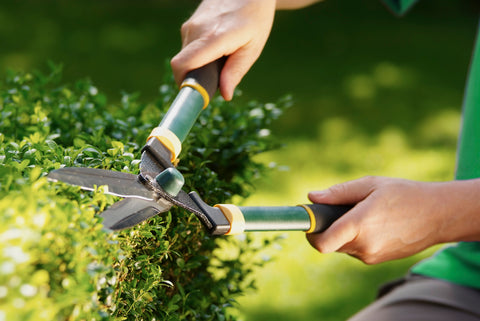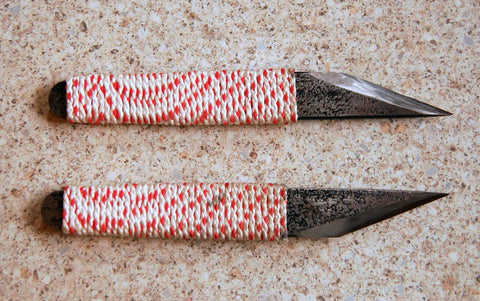A Guide To Essential Gardening Tools

Jump to:
Whether you have a small garden bed, a large residential garden, or a plot of farmland, you’re going to need a range of gardening equipment to keep things growing smoothly. The gardening section at your local hardware store can be a daunting place. When I was just getting started, I couldn’t tell a soil knife from a watering can!
So to help you on your task to turn both thumbs green, we’ve put together this list of the eight must have garden tools for gardens of all sizes.
Shears

If you have a garden with trees or hedges, you’re going to need at least one pair of shears. The issue is deciding which shears you need. There are many different kinds of shears for different jobs, but they all essentially do the same thing: trim and prune twigs, sticks, leaves, and even branches.
Unless you already have a specific type of shears in mind, it’s best to start with a simple pair of pruning shears. A pair of high-quality, handmade pruning shears can last you a lifetime if you care for them properly, and their blades will make quick work of most twigs and small branches to keep your trees, hedges, or woody flowering plants like roses looking prim and proper!
If you’re interested in the botanical art of topiary, that is, trimming trees and shrubs into pretty and neat shapes, a pair of leaf shears (or topiary shears) will quickly become your best friend. Leaf shears have longer blades, and a quick movement, so that you can rapidly slice through leaves and thin sticks to trim and train your trees and shrubs into all kinds of shapes!
The final pair of shears that is essential for many gardens is hedge shears. This one is pretty self-explanatory. Hedge shears are for shearing hedges. Got hedges? Get some hedge shears!
Scissors

Life is full of unanswered questions. Questions like: “Are we alone in the universe?”, “Why are yawns contagious?”, and “What’s the difference between scissors and shears?”.
Well today you’re in luck! Because one of those questions will not go unanswered any longer.
Shears are typically larger, with thicker, sturdier handles, designed to maximize leverage when cutting through thick and tough materials. They often only have one sharpened blade, while the other “blade” is flat, to be pressed against the item being cut to provide stability and control.
Scissors on the other hand are often smaller, with smaller handles to allow for intricate and precise cutting. They usually have two identical blades, to cleanly cut even delicate items.
Scissors are also essential tools in most gardens. There are a few different types of scissors, so it’s best to choose whichever pair (or pairs) suits your needs. Standard garden scissors, like these, are great for pruning away leaves and twigs on delicate plants. They leave a much cleaner cut and are less traumatic to the plant than pruning shears.
Floral scissors are great for pruning and dead-heading flowers, they’re also recommended for harvesting flowers, and trimming them for arrangement or display.
Finally, fruit harvesting scissors can get into tight spaces and easily harvest anything from oranges, to grapes, without causing unnecessary damage to the tree or vine.
A Watering Can

A watering can is an essential gardening tool, especially if you live in an area where water conservation is required. Sure, you can simply water your garden with a hose or sprinkler system, but neither of those will offer the same control as the humble watering can.
You will have far greater control over what gets watered (and more importantly, what doesn't get watered), you will be able to easily control the flow of the water, protecting delicate plants and new transplants from heavy watering, and you won't have to deal with winding up and putting away a hose at the end of the day.
The watering can’s design has barely changed in centuries, because why change what works? A galvanized watering can will be the workhorse of your gardening operation, and it will last you years.
A Pruning Saw

Pruning saws are for cutting down branches that are too thick for pruning shears to handle. Japanese pruning saws in particular are well-known for their fast and effortless cutting ability. Unfortunately, there are so many different types of pruning saws you could end up having a breakdown in the aisle of your local hardware store trying to tell them apart.
That’s why we wrote this guide to pruning saws, which will tell you all about their differences. But to briefly summarize the most common varieties:
- Curved blade pruning saws are for rough and rapid cutting, particularly for branches above your shoulders or below your waist.
- Straight blade pruning saws are for precisely and cleanly cutting through branches located between shoulder and waist height.
- Folding pruning saws are compact and easy to store and transport, but can be quite heavy.
- Fixed-blade pruning saws are stronger, more durable, and more stable, and typically quite lightweight.
Particularly if you have trees, a pruning saw will instantly upgrade your gardening toolkit and make the day-to-day just that much easier.
Felling & Clearing Tools

These tools may not be useful for every garden, but even if you only have a small garden, you may be surprised at how often you reach for your axe when you have one.
Felling tools, like axes and hatchets, are fantastic for not only chopping down trees, but also for taking off branches that are too thick to be bothered sawing through. The Japanese nata axe is the best felling tool for your garden, as the strength and sharpness of its blade, and the balanced weight-distribution eases fatigue, and makes it a lot more user-friendly than the typical axe. Not only that, with just one or two swings, they can cut through most small branches, leaving a very clean wound behind on the trunk of the tree.
A Multi-Purpose Knife

Have you noticed a trend in this list so far? Almost every essential gardening tool is a cutting tool. We’ve listed all different kinds of cutting tools, from saws, to scissors, to axes. But what’s the first thing that comes to mind when you think of cutting? Knives. Knives are the Michael Jordan of cutting tools. And the Japanese higonokami folding knife is the Rolex of knives.
An all-metal construction, with a design that hasn't changed for over 100 years. A steel handle that can take a beating, and an ultra-sharp blade. The blade is the pièce de résistance. Japan's highest grade of carbon steel: Aogami (blue-paper), sandwiched between two layers of soft iron in the traditional warikomi style to protect it from damage.
When it comes to cutting twine and rope, or pieces of hose, opening bags of mulch, or harvesting delicate items like herbs and fruit, a knife is an indispensable tool for any garden. The higonokami is the best choice, but there are many other great options for a multi-purpose gardening knife, like a kiridashi, or a butterfly knife.
Digging & Transplanting Tools

Here’s where we get to introduce you to something groundbreaking (literally). The hori hori tool is one of the most innovative and useful gardening tools from Japan that has recently been making waves across the world. If ever there were a gardening tool that could go viral, it would be the hori hori tool, or Japanese digging knife.
They dig into hard and compacted soil with ease, break up tightly-wound root networks, rip through thick underground roots with their serrated blades, measure soil depth, and even dig and scoop! When it comes to weeding, trenching, harvesting root vegetables, dividing perennials, and creating seed furrows, you can’t go wrong with a hori hori knife!
Another similar, but more single-purpose tool that would be a great addition to any gardening toolkit is a transplanting knife. Typically made from a rust-resistant stainless steel with a durable wooden handle, these very useful planting tools are best used on potted plants. Their offset blades are designed for sliding down the inside of a pot, and they can cut through delicate root systems without causing trauma to the plant you're transplanting or dividing.
Gloves

When we’re gardening there’s one tool that we use more than any other, one tool that’s more important than any other, and is completely irreplaceable: our hands. It’s essential to protect our most important tool by using strong and durable gloves, so that we avoid blisters, cuts, and extra fatigue on our skin and joints.
If you're working with wet and/or slippery plants, especially if you're weeding or harvesting, a good pair of non-slip waterproof gloves will provide the extra grip and protection you need. If you want something a little more multi-purpose, a general pair of non-slip gloves like this will keep your hands safe, sound, and comfortable all day long. Not only are they extra breathable, but you can even use a touchscreen without taking them off thanks to the special rubber pattern on the fingertips.
So there you have it. The eight best gardening tools to instantly upgrade your garden shed. Now what are you waiting for? Those weeds aren’t going to pull themselves!

0 comments